Introduction
In most of our reviews, we tend to focus on the performance of reading and writing large files. Our Windows Filecopy benchmark uses a ripped DVD folder with a few 1 GB VOB files and a mix of smaller files. And the NASPT File Copy tests read and write a single 1.15 GB windows backup file. NAS shoppers (and manufacturers) like to focus on these benchmarks because they produce the highest numbers.
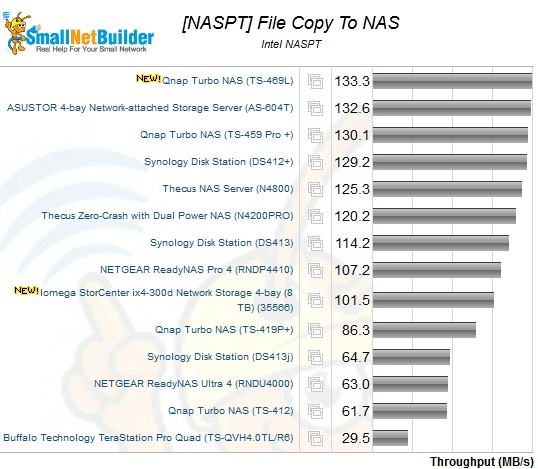
Intel NASPT File Copy to NAS Benchmark – 4 drive NASes, RAID 0
As an example, look at the NASPT File Copy To and From NAS charts shown above and below. These are for RAID 0 volumes and filtered for four-bay NASes. The NASes ranking at the top are based on dual-core Intel Atom CPUs, while those toward the bottom run on less-expensive (and powerful) Marvell SoCs.
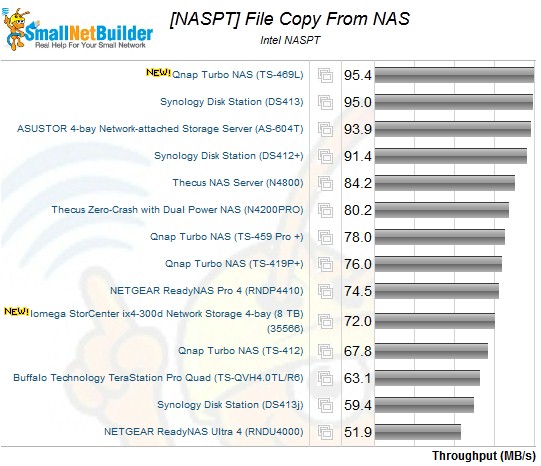
Intel NASPT File Copy to NAS Benchmark – 4 drive NASes, RAID 0
I was talking to someone the other day about high-end NASes and remarked that even multi-core processors can’t do much to improve the performance of small file reads and writes on NASes. This is illustrated best by the NASPT Content Creation and Office Productivity benchmarks.
According to Intel’s description, the Content Creation benchmark is a "scripted routine simulating a user creating a web advertisement from various content sources including video and 3D modeling software. 95% writes with mix of 1k, 4k & little reads. Wide range of writes up to 64kB, mostly sequential". Although there is almost a 2X difference between lowest and highest performance products in the chart below, 14 MB/s is still nothing to write home about.
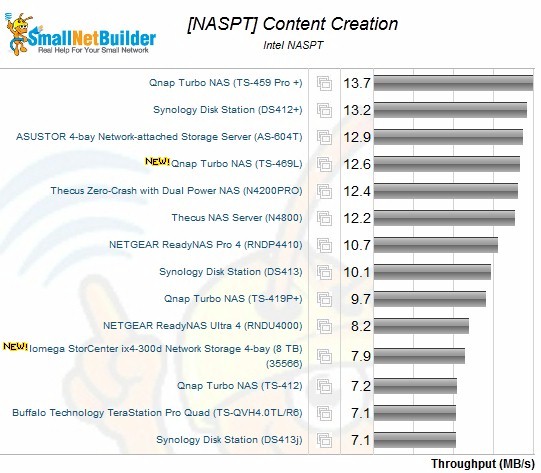
Intel NASPT Content Creation Benchmark – 4 drive NASes, RAID 0
The Office Productivity benchmark has more of a balance of reads and writes, i.e. "Common productivity applications: e-mail, spreadsheet, etc. running scripted routines. Balance of reads & writes, mostly 1k & 4k reads with a large number of smaller reads. Mostly 1kB writes, mostly sequential accesses". The chart of this benchmark, for the same group of NASes produces higher throughput, but less of a spread between lowest and highest performance.
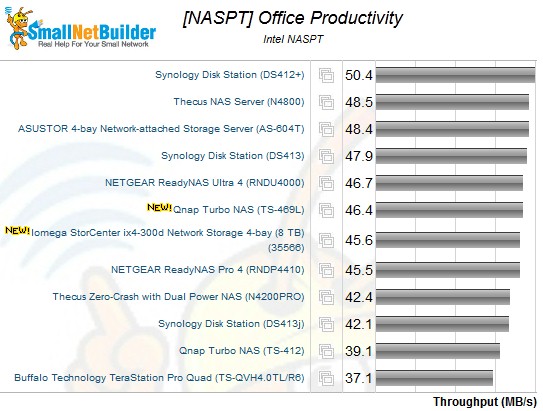
Intel NASPT Content Creation Benchmark – 4 drive NASes, RAID 0
Given the huge difference in performance, it’s hard to believe these charts are showing the same group of NASes! But no amount of processing power can overcome the overhead involved with moving data over a network. Certain bits have to go into each packet to ensure that all the data you send safely arrives at the other end.
When the chunk of data you are moving is big, those overhead bits are a relatively small percentage of the network bandwidth used. But as file sizes get smaller, the overhead packets stay the same size and use up a much larger percentage of transmission time.
iSCSI To The Rescue
So it seems a fact of life that if you want the convenience of a NAS, you’ll have to bite the bullet on performance unless all you deal with are Gigabyte-sized files. But, for some NASes, this might not be the case. Most RAID-class NASes have supported iSCSI for some time. iSCSI (Internet Small Computer System Interface) has been around for awhile and was developed as a SAN (Storage Area Network) protocol.
You can think of iSCSI as a way to provide computers with the illusion of large volumes of direct-attached storage, while the storage actually sits in a NAS or usually larger storage farm somewhere on the network. The QNAP diagram below illustrates the concept.
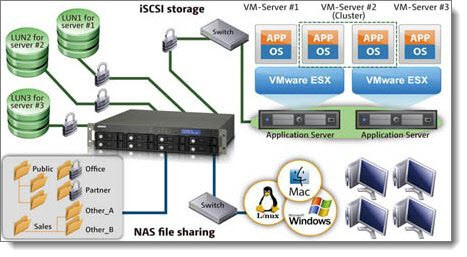
iSCSI concept
iSCSI requires an initiator on the client device that communicates with an iSCSI target running on stirage server. Initiators and targets can be hardware or software based.
Notice earlier that I said direct-attached storage. iSCSI volumes or LUNs (Logical Unit Number) created on iSCSI targets appear to an iSCSI initiator just like physical disks. This is why when you create an iSCSI LUN on a NAS and connect to it using an iSCSI initiator, you need to first format the LUN before you use it.
Just like any direct-attached storage, an iSCSI LUN can’t be shared. (Yes, I know it’s possible to share an iSCSI LUN under specific conditions and with filesystems designed to handle it. But generally, it is not recommended.) Just as you can’t connect a hard drive to two computers at once, you can’t share an iSCSI LUN.
So if you’re giving up one of the main reasons to use a NAS—easily shared storage—what do you gain?
We’ve had iSCI write and read benchmarks as part of our tests for a few years now. But the iSCSI benchmarks run only the Windows File Copy tests, which measure only large file size performance.
That conversation I mentioned earlier made me realize that I had never run the full benchmark suite, which includes the smaller file-size NASPT tests. So that’s what I did. I had a QNAP TS-469L on the bench, which turned in iSCSI write and read results of 101 MB/s and 82 MB/s using a RAID 5 volume. I then ran the entire NAS Benchmark suite and pulled the results and the normal benchmark results (using a standard SMB share) into the table below.
| SMB | iSCSI | % Diff | |
|---|---|---|---|
| FileCopyToNAS | 129.85 | 116.76 | -10% |
| FileCopyFromNAS | 92.56 | 73.21 | -21% |
| DirectoryCopyToNAS | 16.32 | 277.12 | 1598% |
| DirectoryCopyFromNAS | 19.45 | 39.30 | 102% |
| ContentCreation | 9.44 | 17.20 | 82% |
| OfficeProductivity | 43.41 | 51.24 | 18% |
| HDVideo_1Play_1Record | 98.82 | 113.29 | 15% |
| HDVideo_4Play | 113.37 | 102.21 | -10% |
| Windows FileCopy Write | 98.22 | 99.65 | 1% |
| Windows FileCopy Read | 101.93 | 99.65 | -2% |
iSCSI vs. SMB pserformance – QNAP TS-469L
I have to say that I was really surprised by the results! So surprised, that instead of running the iSCSI benchmarks three times, as I normally do, I ran them 10 times, which are the results posted in the table above.
The results show that for the tradeoff of somewhat lower large file copy performance, I was able to post an 82% gain in performance for the NASPT Content Creation benchmark. Office Productivity benchmark improvement was only a more modest 18%, however. I think the difference may be write caching, since the Content Creation benchmark is 95% writes. This guess is reinforced by the 1600% improvement in the NASPT Directory Copy To benchmark, which writes 236 MB consisting of 2,833 files in 44 folders to the NAS. The gain in the read direction is only 102%, i.e. a bit more than double, which is a nice improvement even if it is not as impressive.
Closing Thoughts
Given its non-shared nature, iSCSI isn’t going to be for everyone. And it has its limitations. Even though I was able to create an 8 TB iSCSI LUN on the QNAP, Windows 7 would only let me access 2 TB of it. I couldn’t even format the remaining 6 TB into another volume.
There is also the issue of iSCSI performance. While it is generally true that iSCSI performance (using the Windows File Copy benchmark) tracks SMB-based file copy performance, it doesn’t always. In the comparison chart below, you can see that the numbers for a given NAS run lower and in some cases, like the Synology DS413, significantly lower (61 MB/s vs. 114 MB/s).
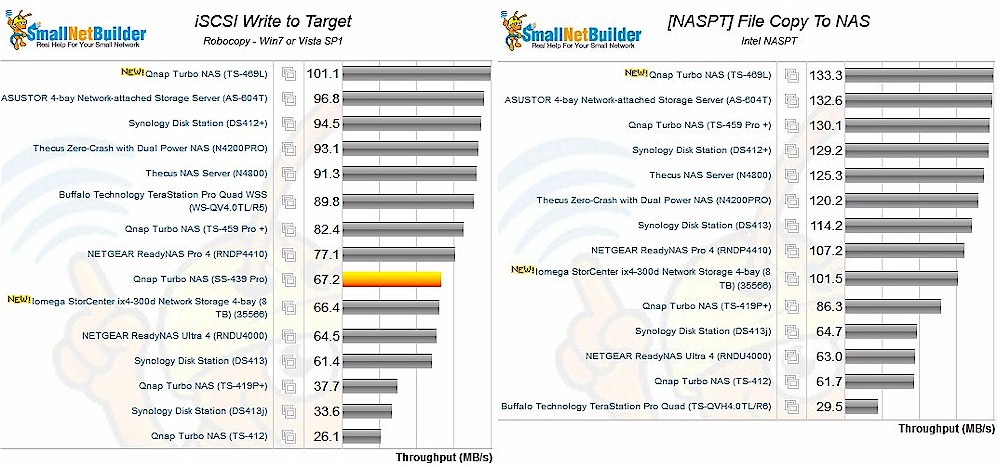
iSCSI vs. File Copy Write performance – 4 bay NASes
Still, if you’ve been wanting to edit files directly on your NAS or just wish you could move folders back and forth a lot more quickly, you might give iSCSI a try. If you can live with iSCSI’s limitations, you might find it can breathe new life into your old NAS!
